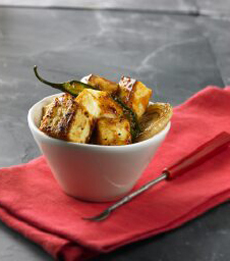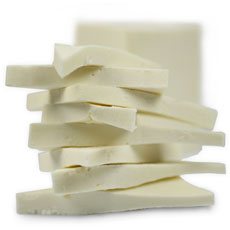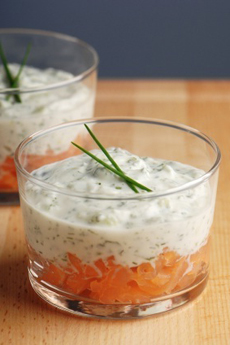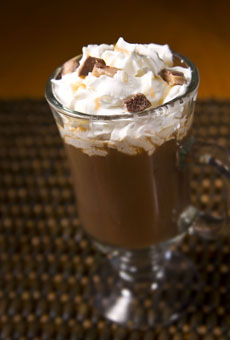|
There’s nothing like fresh-ground nutmeg. The pre-ground product is pallid in comparison.
You may use nutmeg in baking—custards and pumpkin pie, spice cakes and cookies—and it’s de rigueur in egg nog. But what about savory uses?
Following the demise of our decades-old nutmeg mill, we’ve been enjoying our new chrome nutmeg mill from William Bounds. We’ve been adding daily grinds of fresh nutmeg to coffee, eggs and greens.
We asked THE NIBBLE’s chef Johnny Gnall how he uses nutmeg. Here are his favorite uses, along with some musings on nutmeg:
Nutmeg is a bit of an unsung hero. It’s used in a surprisingly large number of recipes and dishes, but it’s rare that you notice it, especially up front on your palate. In fact, that’s kind of the point. Nutmeg is a spice often used to accent other flavors, the same way a recipe uses salt to bring out the flavor of other ingredients.
|
|
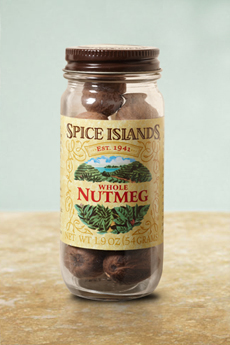
Nutmeg. Photo courtesy Spice Islands. |
|
Nutmeg is often perceived as a “holiday spice,” but it’s delicious year-round. As with other spices, use it up as quickly as you can. Even a whole nutmeg in an airtight jar will dry out in a few years. If you’ve had the nutmeg for a while, pierce it with a pin. If you get a droplet of oil, the spice is still lively.
10 SAVORY SHOWCASES FOR NUTMEG
In desserts, nutmeg is often combined with allspice, cinnamon and clove. But nutmeg on its own is a pretty delicious flavor.
Nutmeg is also a strong flavor, so you only need it in very small doses. Even a pinch can pack a punch that will kick things up a notch.
Here are 10 ways to give new punch to your recipes with nutmeg. Remember to use it sparingly: Start with a tiny bit, taste often and pump the brakes as soon as its flavor gets to the front of your palate.
1. Bacon & Pork Belly
Bacon fans find it practically perfect in every way, virtually impossible to improve upon. It can be amplified, however. The next time you have a recipe with bacon as a primary ingredient (a quiche, perhaps?), try complementing it with a touch of nutmeg. Bacon and nutmeg are at very different ends of the flavor spectrum, but they share earthy roots. You may even start dusting your bacon strips!
2. Béchamel
A classic béchamel sauce is made with a dash of nutmeg early in the cooking process. In most fine-dining restaurants, béchamel is usually the start of mac ‘n cheese and other creamy pasta dishes. If you up the nutmeg just a touch, the new angle on a familiar flavor will surprise you. Just be sure to think ahead: If you are adding béchamel to a dish along with other cheeses or ingredients, be sure the flavors complement one another. Nutmeg doesn’t always play well with others (seafood, yes; mushrooms, not really).
|
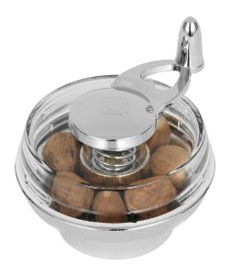
William Bounds nutmeg mill. Photo courtesy
William Bounds. |
|
3. Carrots
Roasted carrots with nutmeg is easy and will knock your socks off. Just toss roasted carrots in a bit of melted butter and season with fresh-ground nutmeg, salt and pepper to taste.
4. Dough
Bread dough, cookie dough, pasta dough, pie/quiche dough: Any of these can benefit from the kick a little nutmeg supplies. As with béchamel, however, make sure that whatever else you are putting in or on that dough does not clash with nutmeg.
5. Goat Cheese & Burrata
Take ordinary goat cheese and add a pinch of nutmeg to make it extraordinary. Add the seasoned goat cheese to salads, use chunks to garnish soup or just spread it on a slice of toasted baguette. Along the same lines of cheese enhancement, go for pure indulgence with burrata: A tiny drizzle of olive oil and a pinch of nutmeg create fireworks in your mouth.
|
6. Hazelnuts
A bowl of warm, toasted hazelnuts sprinkled with nutmeg is as perfect a holiday party snack as you can find. But don’t wait for the holidays: Serve them year-round with cocktails, wine and beer.
7. Lamb
Lamb is a protein that loves nutmeg—perhaps more than any other. If you season the meat with salt and just a teaspoon or so of nutmeg, as opposed to pepper, you will discover a delightful flavor profile. If you’re going to stew lamb, you’re in for a real treat with nutmeg. Remember, though, that with lamb, the “less is more” rule especially applies.
8. Scalloped Potatoes
A little nutmeg in the dish adds depth of flavor, while a dusting over the top will give you an up-front hit of nutmeg that then fades into creamy potato.
9. Spinach & Collard Greens
If you’re braising, add nutmeg early; you may want to re-up as the vegetables cook. If sautéing, a quick sprinkle when your greens start to wilt should do the trick.
10. Squash & Squash Soup
The nuttiness of squash, from acorn to zucchini, is accentuated by a sprinkle of nutmeg.
FOOD TRIVIA
The nutmeg tree produces two different spices, nutmeg and mace. Nutmeg is the seed of the fruit that grows on the tree, and mace is made from a red substance that covers it.
|
|



